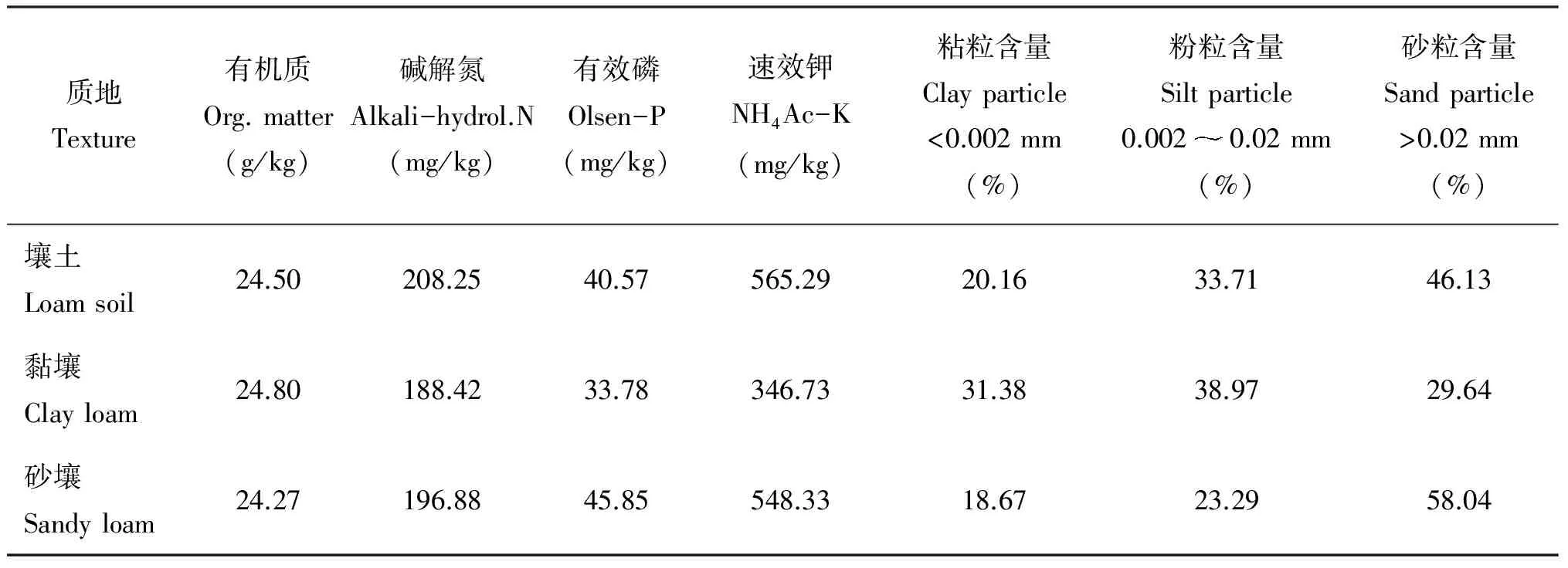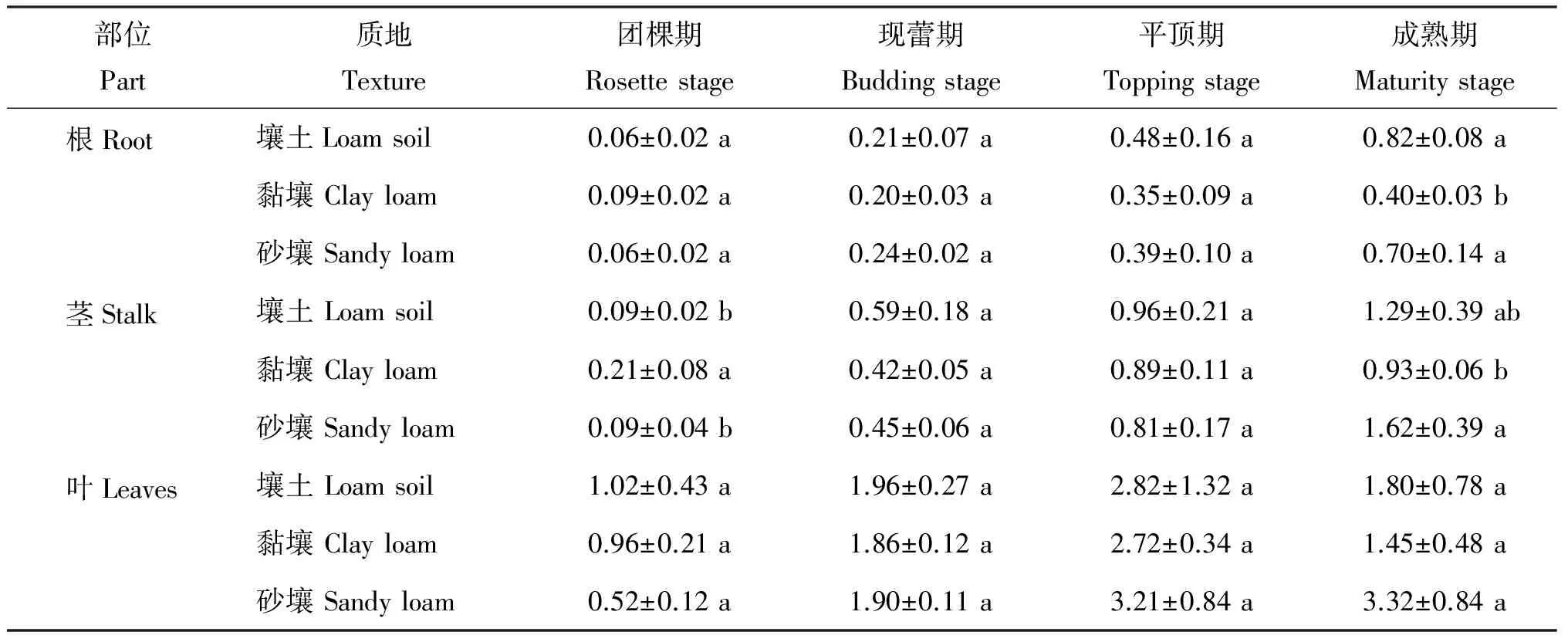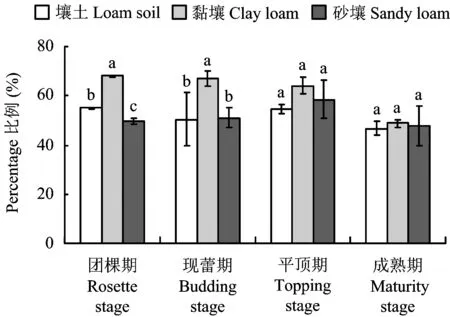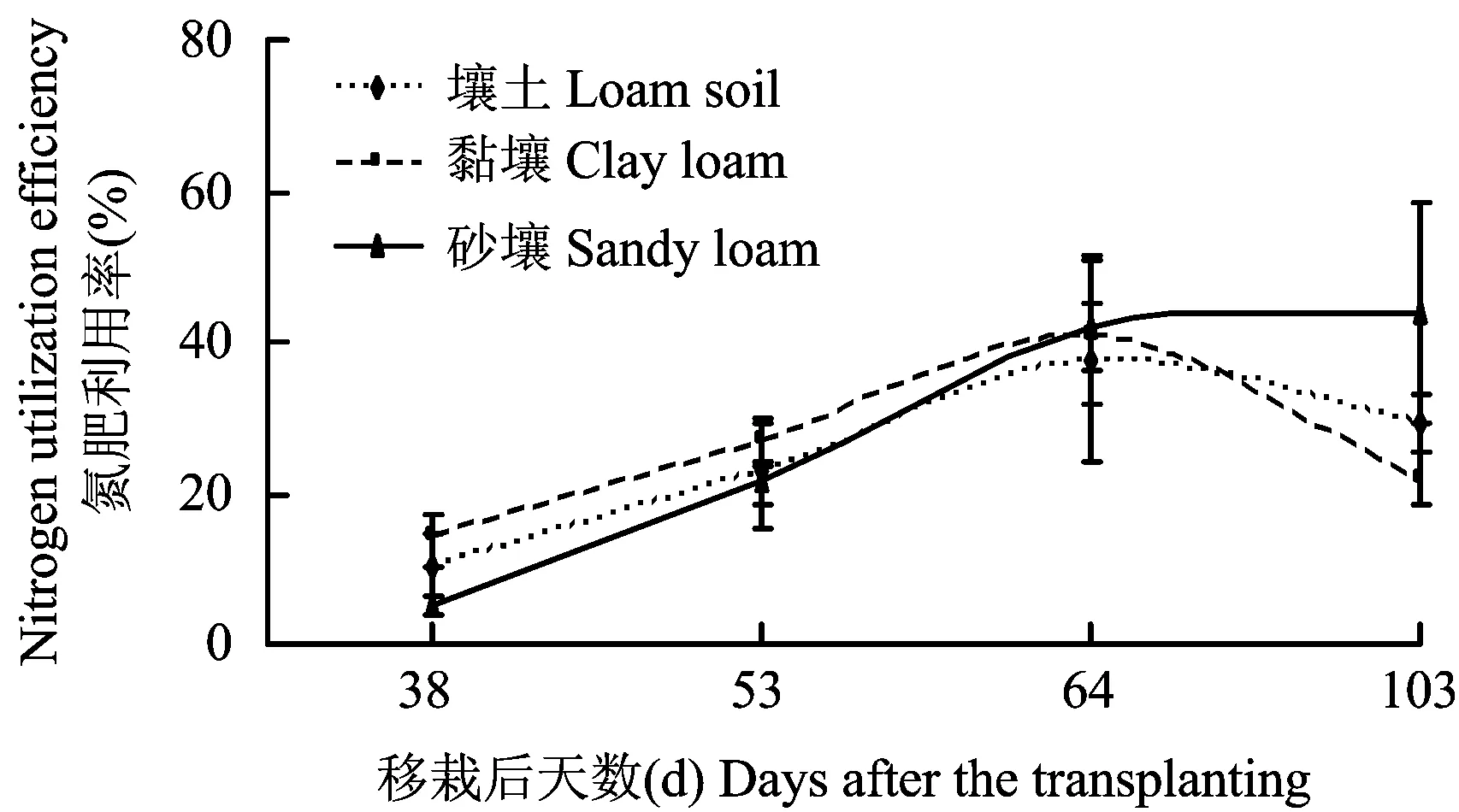不同质地土壤上烤烟氮素积累、分配及利用率的研究
2015-06-15张继光季学军王传义段苏珍张忠锋
朱 佩, 张继光, 薛 琳, 季学军, 王传义, 程 森,段苏珍, 任 夏, 张忠锋*
(1 中国农业科学院烟草研究所,农业部烟草生物学与加工重点实验室,青岛 266101;2 中国农业科学院研究生院,北京 100081; 3 安徽皖南烟叶有限责任公司,安徽宣城 242000;4上海烟草集团有限责任公司,上海 200082)
不同质地土壤上烤烟氮素积累、分配及利用率的研究
朱 佩1,2, 张继光1, 薛 琳3, 季学军3, 王传义1, 程 森4,段苏珍1,2, 任 夏1,2, 张忠锋1*
(1 中国农业科学院烟草研究所,农业部烟草生物学与加工重点实验室,青岛 266101;2 中国农业科学院研究生院,北京 100081; 3 安徽皖南烟叶有限责任公司,安徽宣城 242000;4上海烟草集团有限责任公司,上海 200082)
【目的】土壤质地能概括反映土壤内在的肥力特征,对土壤养分供应具有调控作用,是影响农田中土壤氮素供应和氮肥利用的重要因素。本试验通过在皖南烟区3种质地(壤土、黏壤、砂壤)土壤上施用等量氮肥来研究其对烤烟不同生育期的氮素吸收、积累及利用特征的影响,旨在为烟田土壤改良及烤烟合理施肥提供理论依据。【方法】在皖南烟区现代农业科技园的典型壤土、黏壤和砂壤土上分别建立田间试验,采用15N田间微区试验和室内分析相结合的研究方法,在烤烟的团棵期(移栽后38 d)、现蕾期(移栽后53 d)、平顶期(移栽后64d)和成熟期(移栽后103 d),采集长势一致的烟株样品,测定烟株各部位的生物量,并采用凯氏定氮法检测其全氮含量,采用ZHT-O2型同位素质谱仪测定其15N丰度。【结果】皖南烟区壤土和黏壤土上烤烟总氮和肥料氮积累均随生育期呈单峰变化,在烤烟平顶期达最大,总氮积累量分别为4.25 g/plant和3.96 g/plant,肥料氮积累量分别为2.34 g/plant和2.54 g/plant,而砂壤土上烤烟到成熟期其总氮和肥料氮的积累量达到最大,分别是5.64 g/plant和2.73 g/plant,均显著高于同时期的壤土和黏壤;壤土、黏壤和砂壤土上烤烟均以叶部肥料氮占总氮比例及氮素分配率较高,茎部次之,根部最低;不同质地土壤上烤烟氮肥利用率与肥料氮的积累动态具有一致的变化趋势,其中壤土和黏壤在平顶期最大,分别为34.5%和40.7%,之后壤土利用率缓慢下降,黏壤下降幅度较大,而砂壤土上烤烟氮肥利用率在生育期内呈上升趋势,至成熟期最大,为43.7%。【结论】不同质地土壤上烟株对氮素的吸收利用顺序为砂壤>壤土>黏壤,黏壤土在烤烟生育期内供氮能力较弱,应合理调控土壤氮的矿化及增加肥料氮的供应;砂壤土氮肥利用率较高,应严格控制氮肥的施用量。
土壤质地; 肥料氮; 土壤氮;15N示踪; 烤烟; 氮肥利用率

1 材料与方法
1.1 试验材料
该试验于2012年在安徽省宣城市宣州区黄渡乡现代农业科技示范园内(30°40′49″N,118°46′17″E)进行。该地区属典型亚热带季风气候区,光、温、水热条件优越,年均日照时数为2072.5 h,年平均温度15.8℃,无霜期为228 d,年平均降水量1324.8 mm,该地区的土壤主要是河流冲积母质形成的潴育型水稻土。本试验采用的3种不同质地(壤土、黏壤和砂壤土)土壤的基本理化性状见表1。

表1 试验田不同质地土壤的基本理化性质
1.2 试验设计

1.3 样品采集与测定

全氮采用凯氏法(K-05 自动定氮仪)测定,15N丰度采用ZHT-O2 型质谱仪测定。
1.4 计算方法
植株吸收的氮素来源于肥料和土壤的量及比例的计算参照陈子元的方法[26]:
WN=W1×C1;
Ndff=WN×%Ndff;
Ndfs=WN×(1-%Ndff);
式中:WN—烤烟样品总氮积累量;W1—烤烟样品干重;C1—烤烟样品含氮量;15N1—烤烟样品15N原子百分超;15N2—肥料15N原子百分超;%Ndff—肥料氮占总氮百分数;Ndff—烤烟肥料氮积累量;Ndfs—土壤氮积累量;RN—当季氮肥利用率;W0—肥料的重量;C0—肥料含氮百分数。
1.5 数据处理
试验数据采用Excel 2007和SAS 9.2统计分析软件进行处理。
2 结果与分析
2.1 不同质地土壤上烤烟氮素积累动态
由不同质地土壤上烤烟总氮积累动态(图1A)可知,壤土和黏壤土上烤烟氮素积累动态基本一致,均呈单峰变化,即在移栽后64 d的平顶期氮素积累达到顶峰,总氮积累量分别为4.25 g/plant和3.96 g/plant,之后缓慢下降,至移栽后103 d的成熟期降为3.92 g/plant和2.79 g/plant,砂壤土上,烤烟氮素积累则随移栽后天数的增加呈线性增加趋势,至成熟期氮素积累量达最大为5.64 g/plant。可见,烤烟在砂壤土上较壤土和黏壤具有更强的吸收利用氮素的能力。多重比较结果表明,在烤烟的前3个取样时期,3种质地土壤上烤烟氮素积累量没有明显差异,在成熟期,砂壤土上烤烟氮素积累量显著高于壤土和黏壤(P<0.05),但壤土和黏壤土上烤烟氮素积累量差异不显著。
壤土和黏壤土上烤烟对肥料氮的积累量与其总氮积累变化一致(图1B),同样在平顶期最大,分别为2.34 g/plant和2.54 g/plant,之后迅速下降。砂壤土,烤烟从平顶期到成熟期仍有部分肥料氮的积累,但积累速率较前期明显下降,肥料氮积累量最大值出现在成熟期,为2.73 g/plant。在移栽后38 d的团棵及移栽后53 d的现蕾期,烤烟对土壤肥料氮的积累量顺序为黏壤>壤土>砂壤,在成熟期,则表现为砂壤>壤土>黏壤,说明平顶期前后是烤烟对不同质地土壤肥料氮积累量变化的关键时期。
壤土、黏壤和砂壤土上烤烟对土壤氮的积累量在生育期内呈逐渐增加的趋势(图1C),在成熟期时达到最大值,分别为2.10 g/plant、 1.43 g/plant和2.90 g/plant。其中黏壤土上烤烟土壤氮积累量在整个生育期始终低于壤土和砂壤,说明黏壤土的供氮能力相对较弱,烟株对其吸收利用最少。在平顶期之前,壤土和砂壤土上烤烟对土壤氮的吸收积累量基本一致,而到成熟期,砂壤土上烤烟土壤氮的积累显著高于壤土和黏壤(P<0.05)。

图1 不同质地烤烟和土壤氮素的积累动态Fig.1 N cumulative dynamics of flue-cured tobacco and soil under different soil texture
2.2 不同质地土壤上烤烟器官的氮素积累量
从表2可以看出,在烤烟平顶期之前,不同质地土壤上烤烟根部氮素积累量之间差异不显著(P>0.05),平顶期之后,烤烟根部氮素积累以壤土和砂壤增加较多,显著高于黏壤(P<0.05),至成熟期,壤土、黏壤和砂壤土上烤烟根部氮素积累量分别为0.82 g/plant、 0.40 g/plant和0.70 g/plant。不同质地土壤上烤烟茎部氮素积累量随生育期的推进呈增加趋势。团棵期,黏壤土上烤烟茎部氮素积累量显著高于壤土和砂壤(P<0.05);平顶期至成熟期,砂壤土上烤烟茎部氮素吸收仍在增加,在成熟期达最大,为1.62 g/plant,黏壤土上烤烟茎部对氮素的吸收基本停止,二者积累量差异显著(P<0.05)。从团棵期到成熟期,壤土和黏壤土上烤烟叶部氮素积累变化一致,其烤烟叶部氮素积累量在平顶期达到最大,分别为2.82 g/plant和2.72 g/plant,随后迅速降低。砂壤土上烤烟叶部氮素积累量在现蕾前低于壤土和黏壤,之后砂壤土上烤烟叶部氮素积累逐渐增加,至成熟期达最大值,为3.32 g/plant。
2.3 不同质地土壤上烤烟氮素分配率
从不同质地土壤上烟株吸收氮素在各部位的分配率(表3)可以看出,烤烟吸收的氮素主要集中在叶部,其次是茎部,根分配得最少。在平顶期,烤烟根、茎、上部叶和中部叶氮素分配率在3种质地土壤之间均无显著差异,但下部叶氮素分配率以砂壤土显著高于壤土(P<0.05)。在成熟期,烤烟茎部和3个叶位的氮素分配率在3种质地土壤间差异不显著,但根部氮素分配率以壤土显著高于黏壤和砂壤。总之,从平顶期到成熟期,各土壤上烤烟吸收的氮素更多的向根和茎部转移,且壤土烤烟根部和砂壤土烤烟叶部的氮素分配率相对较高。

表2 烤烟各器官在不同生育期的氮素积累量(g/plant)
注(Note): 同列数据后不同字母表示处理间差异达5%显著水平 Values followed by different letters in a column are significant among treatments at the 5% level.

表3 不同质地土壤烤烟氮素分配率(%)
注(Note): 同列数据后不同字母表示处理间差异达5%显著水平 Values followed by different letters in a column are significant among treatments at the 5% level.
2.4 不同质地土壤下肥料氮在植株中的分布
图2表明,在团棵期,壤土、黏壤和砂壤土上烤烟均以叶部肥料氮占总氮比例较高,分别达到55.5%、68.6%和50.6%,茎部次之,根部最低,分别为49.0%、60.1%和42.3%。根、茎和叶部肥料氮占总氮比例均以黏壤土最高,壤土次之,砂壤最少,说明黏壤土上施用肥料氮对烟株氮素积累贡献较大,壤土次之,砂壤最小。且黏壤土上烤烟茎部和叶部肥料氮占总氮比例显著高于壤土和砂壤(P<0.05)。在现蕾期,3种质地土壤上烤烟各部位肥料氮的分布规律与团棵期基本一致(图2)。



图2 肥料氮在烟株器官的分配状况Fig.2 Distribution of fertilizer N in various flue-cured tobacco organs[注(Note): 方柱上不同字母表示处理间差异显著(P<0.05) Different letters above the bars mean significantly different among treatments(P<0.05).]

图3 不同质地土壤上烤烟吸收肥料氮占总氮的比例Fig.3 Ratios of fertilizer N to total N of flue-cured tobacco in different textured soils[注(Note): 方柱上不同字母表示处理间差异显著(P<0.05) Different letters above the bars mean significantly different among treatments(P<0.05).]
2.5 不同质地土壤上烤烟氮肥利用率

图4 不同质地土壤烤烟氮肥利用率 Fig.4 Nitrogen use efficiency of flue-cured tobacco in different textured soils
从图4可以看出,黏壤土和壤土上烤烟氮肥利用率变化趋势相似。即从团棵到平顶期,氮肥利用率均平稳增加,平顶期时达最大,分别为40.7%和34.5%,且黏壤上烤烟氮肥利用率一直大于壤土,之后黏壤上的氮肥利用率下降幅度较大,至成熟期,黏壤土和壤土上烤烟氮肥利用率分别降为21.7%和29.2%。砂壤土上烤烟氮肥利用率在生育期内一直呈上升趋势,团棵期时,其烤烟氮肥利用率最低,仅为5.3%,至成熟期最高,为43.7%,与黏壤土烤烟氮肥利用率的差异达到显著水平(P<0.05)。可见,土壤质地不同,导致烤烟对肥料氮的吸收利用在生育期间存在明显的差异,其中砂壤土烤烟氮肥利用率前期较低,随生育期逐渐增加,而黏壤及壤土上烤烟氮肥利用率则是在生育期前期增加后期降低。
3 讨论
土壤质地是影响烤烟矿质营养吸收与积累的重要因素[27]。蓟红霞等[28]认为土壤质地对烟株氮素积累量有显著影响,具体表现为粉(砂)质壤土>砂质壤土>壤土,罗新宁等[29]对南疆灌淤土的研究表明,相同处理条件下砂壤土棉株氮的积累量高于重壤土。本研究中在成熟期砂壤土上烤烟氮素积累量最大,显著高于壤土和黏壤,这与上述研究结果一致。此外,烤烟对肥料氮的积累动态略有差异,其中在团棵及现蕾期为黏壤>壤土>砂壤,平顶期之后则表现为砂壤>壤土>黏壤。这与皖南的气候条件有关,在烤烟生育前期,降水较少,黏壤及壤土具有较好的保水性能,因而具有较好的水肥供应能力。在成熟期,适逢雨季高温高湿且降水较多,黏壤及壤土上反而易积水,造成烤烟根系活力下降[30],或影响根系的有氧呼吸造成根系早衰[31],导致烤烟对氮素吸收的减少,因而氮素积累量降低。
烤烟对土壤氮的积累量在生育期内呈逐渐增加趋势,且黏壤土上烤烟土壤氮积累量始终低于壤土和砂壤土,这在一定程度上说明黏壤土有机氮矿化量少,土壤供氮能力较弱。由于土壤中的氮大部分是有机氮,直接决定土壤供氮能力,土壤质地对氮素矿化的影响主要通过控制好氧菌活动,土壤粘粒与土壤有机质的结合等对土壤有机质提供保护,来增加或减少氮素的矿化[32]。有研究表明砂壤土中微生物生物量的C/N高于壤土和黏土,且与单位微生物氮生物量的矿化率呈正相关[33],因此砂壤土的氮矿化及供应能力高于壤土和黏壤,以黏壤土氮矿化最低,其供氮能力也相对最弱。

4 结论
在皖南烟田不同质地土壤上,烤烟对氮素的吸收利用顺序为砂壤>壤土>黏壤,在烤烟成熟期,烟株总氮积累量分别为5.64、 3.92和2.79 g/plant,黏壤的供氮能力较弱,应合理调控土壤氮的矿化及增加肥料氮的供应。烤烟氮肥利用率以砂壤条件下的当季利用率最高为43.7%,壤土次之为29.2%,黏壤土上最低为21.7%,仅为砂壤土的1/2。由于砂壤的氮肥利用率较高,因此应严格控制氮肥的施用量。
[1] 杨宏敏, 陆引罡, 魏成照, 等. 应用15N示踪研究烤烟对氮的吸收及分布[J]. 贵州农业科学, 1991,(5): 29-33. Yang H M, Lu Y G, Wei C Zetal. Absorption and distribution of15N rape seed nitrogen by flue-cured tobacco[J]. Guizhou Agricultural Sciences, 1991, (5): 29-33.
[2] 韩锦峰, 郭培国, 黄元炯, 等. 应用15N示踪法探讨烟草对氮素利用的研究[J]. 郑州: 河南农业大学学报, 1992, 26(3): 224-227. Han J F, Guo P G, Huang Y Jetal. Studies on nitrogen utilization with15N rape seed by flue-cured tobacco[J]. Zhengzhou: Journal of Henan Agricultural University, 1992, 26(3): 224-227.
[3] 郭培国, 陈建军, 郑燕玲. 应用15N示踪法研究烤烟的氮素营养[J]. 中国烟草学报, 1998, 4(2): 64-68. Guo P G, Chen J J, Zheng Y L. Studies on nitrogen nutrient with15N rape seed by flue-cured tobacco[J]. Acta Tabacaria Sinica, 1998, 4(2): 64-68.
[4] 苏帆, 付利波, 陈华, 等. 应用15N研究烤烟对饼肥氮素的吸收利用规律[J]. 中国生态农业学报, 2008, 16(2): 335-339. Su F, Fu L B, Chen Hetal. Absorption and utilization of15N rape seed cake fertilizer by flue-cured tobacco[J]. Chinese Journal of Eco-Agriculture, 2008, 16(2): 335-339.
[5] 中国农业科学院烟草研究所. 中国烟草栽培学[M]. 上海: 上海科学技术出版社, 2005. 309-320. Tobacco Research Institute of Chinese Academy of Agricultural Sciences. Chinese tobacco cultivation[M]. Shanghai: Shanghai Science and Technology Press, 2005. 309-320.
[6] 张延春, 陈治峰, 龙怀玉, 罗春燕.不同氮素形态及比例对烤烟长势、产量及部分品质因素的影响[J]. 植物营养与肥料学报, 2005, 11(6): 787-792. Zhang Y C, Chen Z F, Long H Y, Luo C Y. Effect of different nitrogen forms and their ratio on agronomical character, economic and quality of flue-cured tobacco[J]. Plant Nutrition and Fertility Science, 2005, 11(6): 787-792.
[7] 化党领, 黄向东, 刘世亮, 等. 氮素形态和数量对烤烟干物质积累及钾含量和积累量的影响[J]. 河南农业科学, 2005, (5): 49-52. Hua D L, Huang X D, Liu S Letal. Effects of nitrogen form and concentration on flue-cured tobacco dry matter accumulation and potassium content and accumulation[M]. Journal of Henan Agricultural Science, 2005, (5): 49-52.
[8] Cheng L L, Wen Q X, Li H. Transformation of15N labeled fertilizer N in soils under greenhouse and field conditions[J]. Acta Pedologica Sinica, 1989, 26(2): 124-130.
[9] Shi S L, Liao H Q, Wen Q X. Fate of N from green manures and ammonium sulfate[J]. Pedosphere, 1991, 1(3): 219-227.
[10] 朱兆良, 文启孝. 中国土壤氮素[M]. 南京: 江苏科学技术出版社, 1992. 213-249. Zhu Z L, Wen Q X. Soil nitrogen of China[M]. Nanjing: Jiangsu Science and Technology Press. 1992. 213-249.
[11] 蔡贵信, 范晓晖. 土壤氮素和氮肥的有效施用[A]. 鲁如坤. 土壤-植物营养学原理和施肥[M]. 北京: 化学工业出版社, 1998. 112-151. Cai G X, Fan X H. The effective application of soil nitrogen and nitrogen[A]. Lu R K. Soil and plant nutrition and fertilization[M]. Beijing: Chemical Industry Press, 1998. 112-151.
[12] 张绍林, 朱兆良, 徐银华. 黄泛区潮土—冬小麦系统中尿素的转化和化肥氮去向的研究[J]. 核农学报, 1989, 3(1): 9-15. Zhang S L, Zhu Z L, Xu Y H. Studies on carbamide transformation and fertilizer nitrogen fate in alluvial soil of Huanghuai district-winter wheat[J]. Acta Agriculturae Nucleatae Sinica, 1989, 3(1): 9-15.
[13] 吴海卿, 杨传福, 孟兆江. 应用15N示踪技术研究土壤水分对氮素有效性的影响[J]. 土壤肥料, 2000, (1): 16-18. Wu H Q, Yang C F, Meng Z J. Effects on nitrogen availability of soil water content with15N rape seed[J]. Soil and Fertilizer, 2000, (1): 16-18.
[14] 刘喜庆, 林开创, 王旭峰, 等.15N示踪探究烤烟氮素吸收分配规律[J]. 江西农业学报, 2013, 25(4): 76-77. Liu X Q, Lin K C, Wang X Fetal. Study on nitrogen absorption and distribution patterns in flue-cured tobacco by15N trace[J]. Acta Agriculturae Jiangxi, 2013, 25(4): 76-77.
[15] 时映. 利用15N研究烤烟氮素吸收分配规律[D]. 郑州: 河南农业大学硕士学位论文, 2008. Shi Y. Studies on tobacco plant’s absorption and distribution of nitrogen by using15N[D]. Zhengzhou: Ms thesis of Henan Agricultural University, 2008.
[16] 翟琨, 向东山. 贵州省植烟土壤氮素释放特征研究Ⅱ—不同栽培措施对黔南烟区土壤供氮动态的影响[J]. 安徽农业科学, 2006, 34(5): 953, 978. Zhai K, Xiang D S. Studies on nitrogen release of tobacco-growing soils in Guizhou province-effects on soil nitrogen supply with different cultivation measures in Qiannan tobacco-growing areas[J]. Journal of Anhui Agricultural Sciences, 2006, 34(5): 953,978.
[17] 王帅. 不同种植模式对烤烟氮素吸收、利用、分配的影响[D]. 北京: 中国农业科学院硕士学位论文, 2010. Wang S. Effect on nitrogen absorption, utilization and distribution of different planting pattern[D]. Beijing: Ms thesis of Chinese Academy of Agricultural Sciences, 2010.
[18] 化党领, 张诗卉, 王瑞, 等. 土壤氮和15N肥料氮在不同生长期烤烟各器官的积累[J]. 中国烟草学报, 2013, 19(1): 32-36. Hua D L, Zhang S H, Wang Retal. Accumulation of nitrogen from soil and15N-labeled fertilizer in different organs of flue-cured tobacco at different growth stage[J]. Acta Tobacco Sinica, 2013, 19(1): 32-36.
[19] 封幸兵, 李佛琳, 瞿兴, 等. 烤烟对饼肥和秸秆肥中15N的吸收利用[J]. 烟草科技, 2005,7(1): 31-34. Feng X B, Li F L, Qu Xetal. Flue-cured tobacco fertilization: absorption and utilization of15N in cake and straw manures[J]. Tobacco Science and Technology, 2005,7(1): 31-34.
[20] 杨志晓, 刘化冰, 柯油松, 等. 广东南雄烟区烤烟氮素累积分配及利用特征[J]. 应用生态学报, 2011, 22(6): 1450-1456. Yang Z X, Liu H B, Ke Y Setal. Nitrogen uptake and allocation characteristics of flue-cured tobacco in Nanxiong tobacco-planting area of Guangdong province[J]. Chinese Journal of Applied Ecology, 2011, 22(6): 1450-1456.
[21] 习向银, 晃逢春, 李春俭. 利用15N示踪法研究土壤氮对烤烟氮素累积和烟碱合成的影响[J]. 植物营养与肥料学报, 2008, 14(6): 1232-1236. Xi X Y, Huang F C, Li C J. Effect of soil-N on nitrogen and nicotine accumulation in flue-cured tobacco using15N-traced method[J]. Plant Nutrition and Fertility Science, 2008, 14(6): 1232-1236.
[22] 马兴华, 张忠锋, 荣凡番, 等. 高低土壤肥力条件下烤烟对氮素吸收、分配和利用的研究[J]. 中国烟草科学, 2009, 30(1): 1-4, 9. Ma X H, Zhang Z F, Rong F Petal. Studies on nitrogen absorption, distribution and utilization in flue-cured tobacco under higher and lower fertility conditions[J]. Chinese Tobacco Science, 2009, 30(1): 1-4, 9.
[23] 徐照丽, 杨宇虹. 不同前作对烤烟氮肥效应的影响[J]. 生态学杂志, 2008, 27(11): 1926-1931. Xu Z L, Yang Y H. Influence of different preceding crops on nitrogen fertilizer effect of flue-cured tobacco[J]. Chinese Journal of Ecology, 2008, 27(11): 1926-1931.
[24] 谢志坚, 涂书新, 李进平, 等. 移栽期和氮肥对烤烟产量、产值及氮素吸收利用的影响[J]. 核农学报, 2009, 23(3): 513-520. Xie Z J, Tu S X, Li J Petal. Effects of transplanting time and nitrogen fertilizer on the yield, market value and N uptake of flue-cured tobacco by using15N tracing technique[J]. Acta Agriculturae Nucleatae Sinica, 2009, 23(3): 513-520.
[25] 秦艳青, 李春俭, 赵正雄, 等. 不同供氮方式和施氮量对烤烟生长和氮素吸收的影响[J]. 植物营养与肥料学报, 2007, 13(3): 436-442. Qin Y Q, Li C J, Zhao Z Xetal. Effects of rates and methods of N application on growth and N uptake of flue-cured tobacco[J]. Plant Nutrition and Fertility Science, 2007, 13(3): 436-442.
[26] 陈子元, 温贤芳, 胡国辉. 核技术及其在农业科学中的应用[M]. 北京: 科学技术出版社, 1983. 466-484. Chen Z Y, Wen X F, Hu G H. Nuclear technology and its application in agricultural science[M]. Beijing: Science and Technology Press, 1983. 466-484.
[27] 石俊雄, 王发鹏, 陈雪, 李志宏. 黄壤质地对烤烟氮素吸收累积研究[J]. 西南农业学报, 2009, 22(3): 697-701. Shi J X, Wang F P, Chen X, Li Z H. Nitrogen absorption and accumulation of tobacco plants planted in yellow soil texture[J]. Southwest China Journal of Agricultural Sciences, 2009, 22(3): 697-701.
[28] 蓟红霞. 土壤条件对烤烟生长、养分累积和品质的影响[D]. 北京: 中国农业科学院硕士学位论文, 2006. Ji H X. Effects of soil conditions on the growth, nutrients accumulation and quality of flue-cured tobacco[D]. Beijing: Ms thesis of Chinese Academy of Agricultural Sciences, 2006.
[29] 罗新宁, 陈冰, 张巨松, 蒋平安. 氮肥对不同质地土壤棉花养分动态积累与氮素利用率的影响[J]. 土壤通报,2010,41(4): 904-910. Luo X N, Chen B, Zhang J S, Jiang P A. Effect of nitrogen applied levels on the dynamics of biomass, nitrogen accumulation of cotton plant in different soil textures[J]. Chinese Journal of Soil Science, 2010, 41(4): 904-910.
[30] 李金才, 魏凤珍, 王成雨, 尹钧. 孕穗期土壤渍水逆境对冬小麦根系衰老的影响[J]. 作物学报, 2006, 32(9): 1355-1360. Li J C, Wei F Z, Wang C Y, Yin J. Effects of waterlogging on senescence o f root system at booting stage in winter wheat[J]. Acta Agronomica Sinica, 2006, 32(9): 1355-1360.
[31] 陈强, 郭修武, 胡艳丽, 等. 淹水对甜樱桃根系呼吸强度和呼吸酶活性的影响[J]. 应用生态学报, 2008, 19 (7): 1462-1466. Chen Q, Guo X W, Hu Y Letal. Effects of waterlogging on root respiration intensity and respiratory enzyme activities of sweet cherry[J]. Chinese Journal of Applied Ecology, 2008, 19 (7): 1462-1466.
[32] Hassink T, Bonwman L A, Zwark K Betal. Relationship between habitable pore space, soil biota and mineralization rates in grassland soils[J]. Soil and Biochemistry, 1993, 25: 47-55.
[33] Hassink T, Bonwman L A, Zwark K Betal. Relationships between soil texture, physical protection of organic matter. Soil Biota and C and N mineralization in grassland soils[J]. Geoderrna, 1993, 57: 105-128.
[34] 宇万太, 周桦, 马强, 沈善敏. 氮肥施用对作物吸收土壤氮的影响-兼论作物氮肥利用率[J]. 土壤学报, 2010, 47(1): 90-96. Yu W T, Zhou H, Ma Q, Shen S M. Effect of N fertilizer on uptake of soil N by crops with special discussion on fertilizer nitrogen recovery rate[J]. Pedologica Sinica, 2010, 47(1): 90-96.
Nitrogen accumulation, distribution and use efficiency of flue-cured tobacco under different soil texture
ZHU Pei1,2, ZHANG Ji-guang1, XUE Lin3, JI Xue-jun3, WANG Chuan-yi1, CHENG Seng4, DUAN Su-zhen1,2, REN Xia1,2, ZHANG Zhong-feng1*
(1TobaccoResearchInstituteofCAAS/KeyLaboratoryofTobaccoBiologyandProcessing,MinistryofAgriculture,QingdaoShandong266101,China; 2GraduateSchoolofCAAS,Beijing100081,China; 3AnhuiWannanTobaccoLeafCo.Ltd,Xuancheng,Anhui242000,China; 4ShanghaiTobaccoGroupLimitedLiabilityCompany,Shanghai200082,China)
【Objectives】 Soil texture generally reflects inherent soil fertility, affectes soil nutrient supply, especially soil nitrogen supply and nitrogen fertilizer utilization in farmlands. In this study, the nitrogen absorption, accumulation and utilization of flue-cured tobacco in different soil texture in south Anhui were studied to provide a scientific basis for local rational fertilization in flue-cured tobacco. 【Methods】 A field experiment was established in loam, clay loam and sandy loam soils in the modern agricultural science park of south Anhui tobacco planting area. The15N field trials combined with laboratory analysis were conducted in this study. The biomass amounts of different parts of flue-cured tobacco were measured after blenching and drying of these samples, which were taken from the field trial with the similar growing trend at the rosette stage (38 days after the transplanting), budding stage (53 days after the transplanting), topping stage (64 days after the transplanting) and maturity stage (103 days after the transplanting) of flue-cured tobacco. The total nitrogen contents of different parts of flue-cured tobacco were measured by the kjeldahl nitrogen determination method, and the abundances of15N were measured by ZHT-O2 mass spectrometer. 【Results】 The total nitrogen contents and fertilizer nitrogen accumulation amounts of tobacco in loam soil and clay loam soil both exhibit a single peak pattern during the growing season, and reach their maximum values at the topping stage, with the total nitrogen 4.25 g/plant and 3.96 g/plant, and the fertilizer nitrogen 2.34 g/plant and 2.54 g/plant, respectively. The total nitrogen content and fertilizer nitrogen accumulation amount of tobacco in sandy loam soil reach their maximum values at the maturity stage, with the total nitrogen 5.64 g/plant and fertilizer nitrogen 2.73 g/plant which are significantly higher than those in loam soil and clay loam soil at the same stage. The ratios of fertilizer nitrogen to total nitrogen and the nitrogen distribution rates of tobacco in three soils are all highest in leaves, followed by stems, and lowest in roots. The change tendencies of nitrogen use efficiencies of tobacco at different developmental stages are similar to those of the fertilizer nitrogen accumulation in the three soils. The maximum values of nitrogen use efficiencies in loam soil and clay loam soil are observed at the topping stage and are 34.5% and 40.7% respectively. And then, the values decrease gradually in loam soil and rapidly in clay loam soil with the developmental stage. The nitrogen utilization efficiency of tobacco in sandy loam soil increases with the developmental stage and reaches the maximum value of 43.7% at the maturity stage. 【Conclusions】 The order of nitrogen absorption and utilization of tobacco in different soils is sandy loam > loam > clay loam. Due to its weak nitrogen supply capacity, nitrogen mineralization in clay loam soil should be promoted and more nitrogen fertilizer should be applied for growing tobacco. While, less nitrogen fertilizer should be used in sandy loam soil because of its higher nitrogen utilization efficiency.
soil texture; fertilizer nitrogen; soil nitrogen;15N-tracing approach; flue-cured tobacco; nitrogen use efficiency
2013-12-02 接受日期: 2014-01-20
国家自然科学基金(41201291);中国烟草总公司科技项目(110200902030);上海烟草集团公司科技项目(2012-025)资助。
朱佩(1986—),男,安徽蚌埠人,硕士研究生,主要从事作物高产优质高效栽培工程方面的研究。E-mail: zhp19880612@126.com * 通信作者 E-mail: zhangzhongfeng@caas.cn
S572.01; S606+.1
A
1008-505X(2015)02-0362-09
